80 years ago the battle for Right Bank Ukraine ended
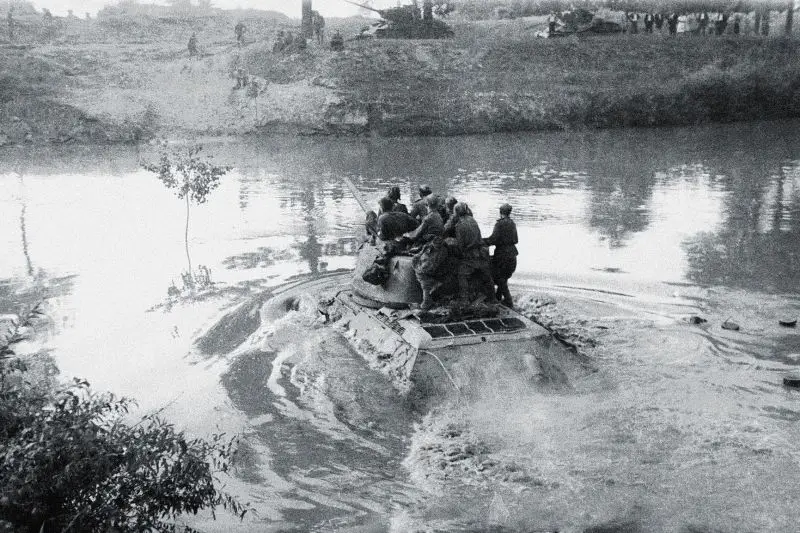
Crossing the Dniester River tanks T-34-85 of the 44th Guards Tank Brigade of the 11th Guards Tank Corps of the 1st Guards Tank Army
80 years ago, the victory of the Red Army ended the battle for Right Bank Ukraine - the Dnieper-Carpathian operation. It was one of the largest operations of the war, involving a total of about 4 million soldiers on both sides.
General situation
After the defeat on the Left Bank of the Dnieper, the Germans continued to hold most of Western Ukraine. The Fuhrer wanted to own the resource-rich regions of Ukraine, maintain positions in the Crimea and return the strategic line on the Dnieper in order to keep the Red Army as far as possible from the German Empire and its European satellites.
The German High Command believed that the next major Russian offensive would be in the south, but they did not expect it so soon, immediately after the Battle of the Dnieper. That the Russians will attack on the move, without an operational pause to restore armies or replenish mobile formations with equipment.
On the Right Bank, two German army groups, “South” and “A,” held the defense. In total, more than 1,7 million people, 16 guns and mortars, 800 tanks and self-propelled guns, about 2 thousand aircraft.
These troops were opposed by the 1st, 2nd, 3rd and 4th Ukrainian Fronts, which had 2,3 million soldiers and officers, 28,8 thousand guns and mortars, over 2 thousand tanks and self-propelled guns, 2,3 thousand aircraft. The Red Army had some superiority in forces, the Soviet military-industrial complex and the rear had the opportunity to quickly replenish the army's losses in manpower and equipment.
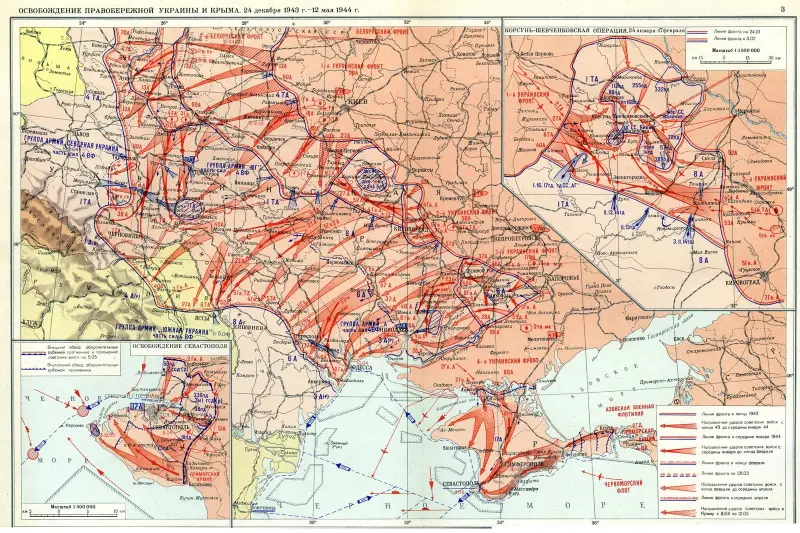
Main battles
At the end of December 1943, the 1st Ukrainian Front under the command of General Vatutin was the first to attack. The enemy's defenses were penetrated up to 300 km wide and 100 km deep. Soviet troops liberated Korosten, Brusilov, Kazatin, Skvira and other cities and settlements.
The German command at this moment tried to launch a counteroffensive with the goal of recapturing Kyiv and returning the “Eastern Wall” on the Dnieper. 12 divisions removed from other sectors of the front were transferred to the Kiev direction. Extremely fierce fighting took place in the area of Zhitomir, Berdichev and Bila Tserkva.
The Nazis failed to recapture Kyiv, but the offensive of the southern wing of the 1st UV was suspended. Vatutin's armies advanced 200 km and went on the defensive. In three weeks of stubborn fighting, our troops almost completely liberated the Kyiv and Zhitomir regions (Fierce battle for Zhitomir and Berdichev), part of Vinnytsia and Rivne regions. Russian troops created a threat to the left flank of the Korsun-Shevchenko group of the Wehrmacht.
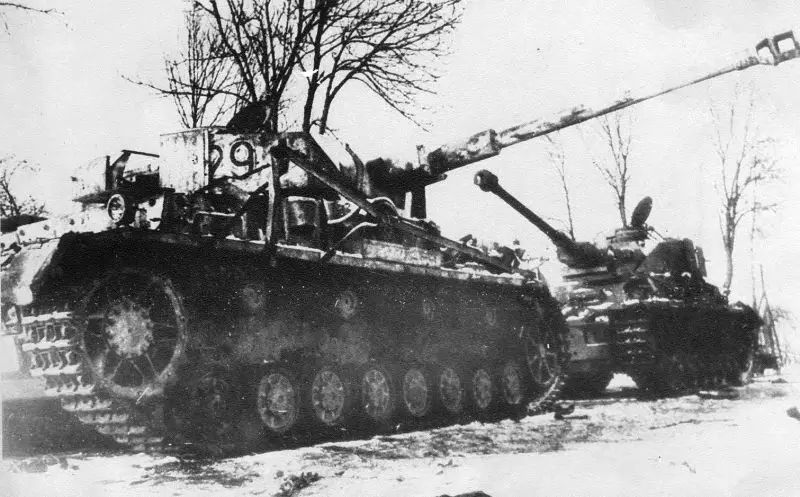
German medium tanks Pz. Kpfw. IV Ausf. G of late series, abandoned in the Zhitomir region. 1st Ukrainian Front. December 1943
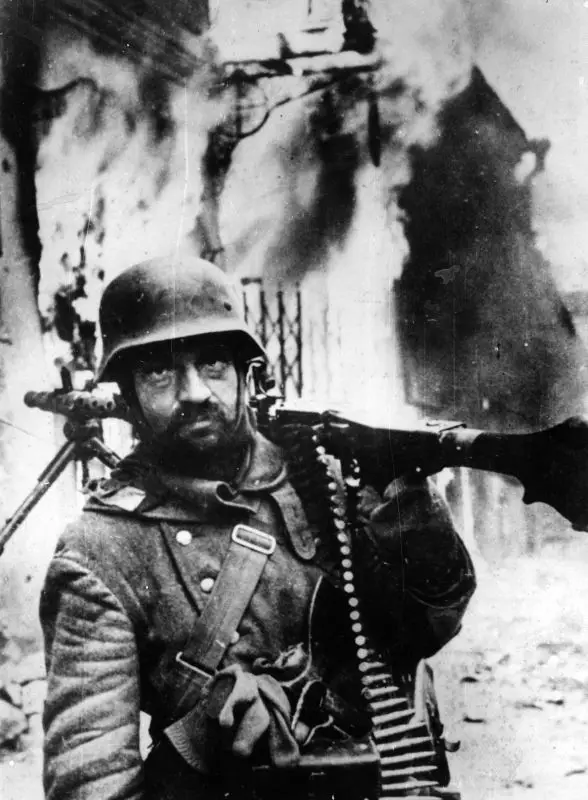
A German machine gunner in the burning center of the city of Zhitomir, for the liberation of which troops of the Soviet 1st Ukrainian Front fought. The soldier is armed with an MG-34 machine gun. Zhitomir was liberated on November 12, 1943, abandoned on November 20, and finally liberated on December 31, 1943.
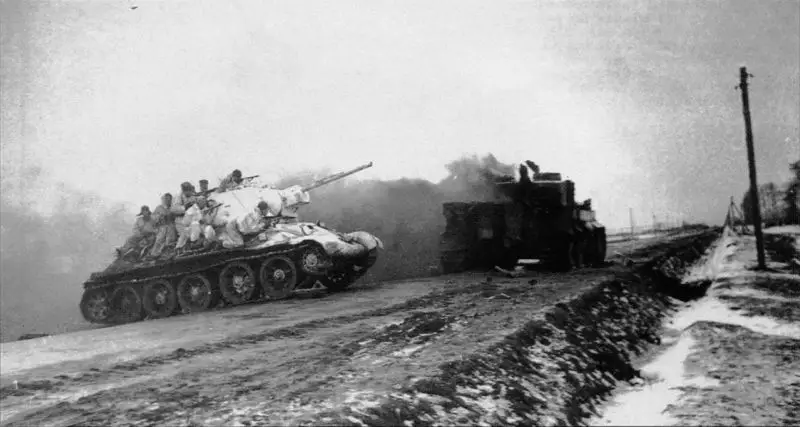
A Soviet T-34 tank with troops crosses the Zhitomir-Berdichev highway. Burning tank Pz. Kpfw. VI "Tiger". 1st Ukrainian Front. January 1944
On January 5, 1944, the 2nd Ukrainian Front (2nd UV) under the command of Konev went on the offensive. Soviet troops liberated Kirovograd in the middle of the month, creating a threat to the right flank of the Korsun-Shevchenko enemy group (How Konev's armies liberated Kirovograd).
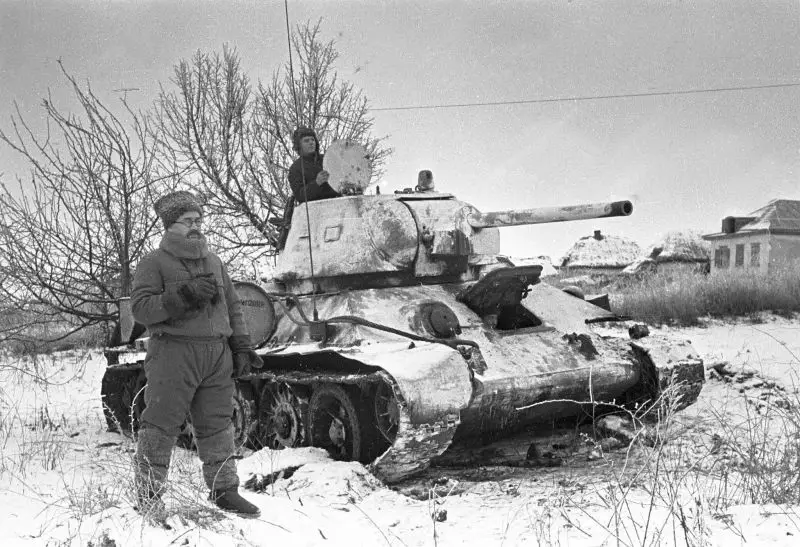
Colonel General of Tank Forces Pavel Rotmistrov, commander of the 5th Guards Tank Army, near the T-34 tank during the Kirovograd offensive operation. January-February 1944
On January 24, 1944, the 4th Guards, 53rd and 5th Guards Tank Armies of the 2nd UV attacked near Korsun-Shevchenkovsky. A day later, the strike force of the 1st UV went on the offensive - the 40th, 27th and 6th tank armies of the 1st UV. Shock groups of two Soviet fronts united in the Zvenigorodka area. By February 3, an encirclement ring was created.
Part of the German group was surrounded. The Germans launched a unblocking counterattack, but were unable to break through a corridor to their own. To repel enemy counterattacks, the Headquarters brought its reserve into battle - Bogdanov’s 2nd Tank Army. By February 17–18, the boiler was liquidated. Only part of the German group, abandoning heavy weapons, was able to break through to their own (Defeat of the German 1st Tank and 8th Field Armies in the Battle of Korsun-Shevchenko).
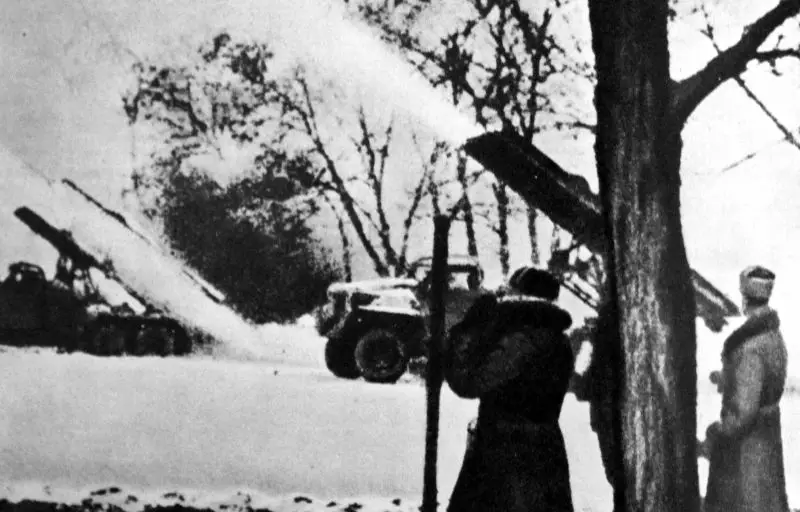
Volley of Soviet Guards mortars under Korsun-Shevchenkovsky
In the first half of February 1944, troops of the 1st UV liberated Lutsk, Rivne and Shepetivka. Troops of the 3rd and 4th UV under the command of Generals Malinovsky and Tolbukhin defeated Nikopol during February (The assault on the Nikopol bridgehead and the defeat of the German 6th Army) and Krivoy Rog enemy groups, liberated Apostolovo, Nikopol and Krivoy Rog.
As a result of the successful January-February offensive of the Red Army, conditions were created for the complete expulsion of the enemy from the Right Bank of the Dnieper. This task was set by Headquarters to the 1st, 2nd and 3rd UV. The 4th Ukrainian Front solved the task of liberating Crimea. The German army suffered irreparable losses in personnel, weapons and technology.
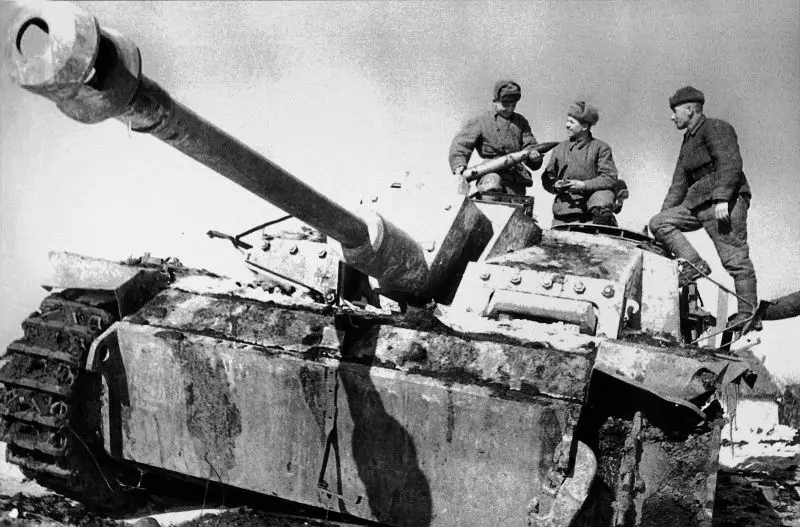
Soldiers of the 3rd Ukrainian Front examine a shell from a captured German self-propelled gun StuG III Ausf. G on the road to Nikopol. The vehicle has winter camouflage; the surviving track shows anti-slip teeth, which were used to improve performance on ice or hard snow. The city of Nikopol was liberated on February 8, 1944.
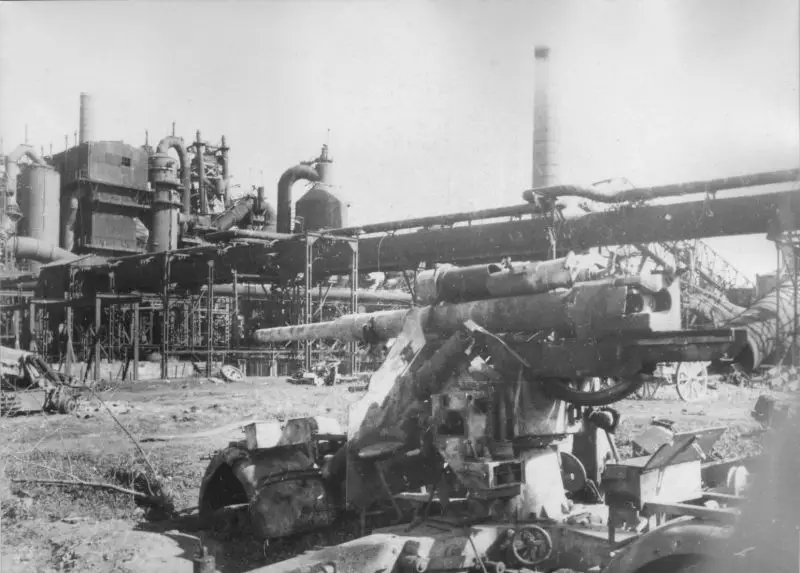
German 88-mm anti-aircraft gun FlaK 36, destroyed on the territory of the metallurgical plant "Krivorozhstal" in Krivoy Rog
Second stage: Southern Bug - Dniester
The Soviet fronts were preparing to continue the offensive. Regrouping of forces and replenishment were carried out. The Germans also replenished their formations, but their human and material resources were already noticeably inferior to those of the Soviets. The German Reich was losing the war by attrition. The Soviet fronts increased their advantage in forces and means. It became especially noticeable in the number of tanks and self-propelled guns (2,5 times predominance).
On March 4, 1944, troops of the 1st UV under the command of Zhukov went on the offensive, liberated a number of cities and cut the Tarnopol-Proskurov and Lvov-Odessa railways (How Zhukov defeated Army Group South on the Right Bank). The main forces of Army Group South were surrounded from the west, and the main line of communication of the entire southern wing of the German army was intercepted. In an effort to stop the further advance of the 1st UV, the German command began hastily transferring reserves to threatened areas. The Germans launch a series of strong counterattacks. Zhukov's armies went on the defensive.
Meanwhile, the troops of the 2nd UV began the Uman-Botoshan operation and, breaking enemy resistance, liberated Uman on March 11, reached the Southern Bug and crossed it on the move (How Konev defeated the 8th German Army and liberated Uman). The 8th Army of the Wehrmacht was defeated and retreated. On March 6, 1944, the troops of the 3rd UV began an offensive, on March 8 they occupied the New Bug, and in the Voznesensk area they reached the Southern Bug. The German 6th Army was defeated.
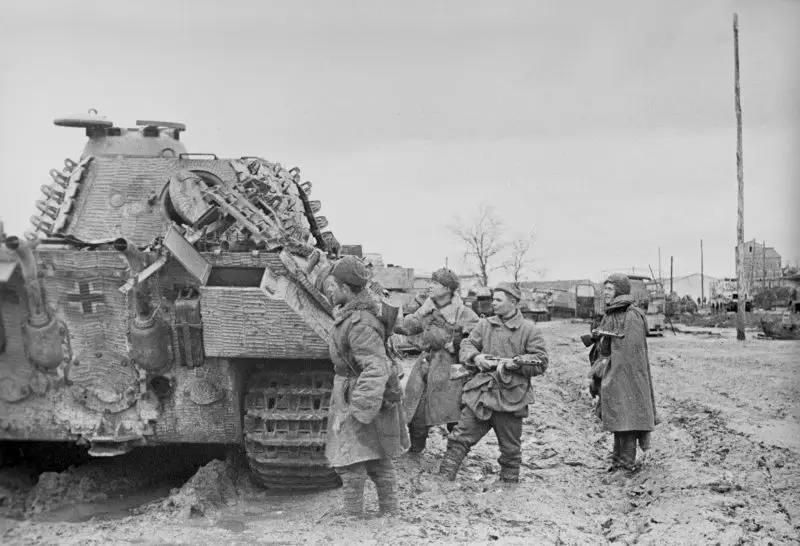
Soviet soldiers inspect a German Pz tank captured in the city of Uman. Kpfw. V Ausf. A "Panther" three days after the liberation of the city from the invaders on March 10, 1944
The German army was unable to repel attacks from three Soviet fronts at once. The defense crumbled. The German divisions suffered serious losses and retreated. Hitler's headquarters demanded to fight to the death and tried to stabilize the situation with urgent measures, sending 8 divisions from Germany, Yugoslavia, France and Belgium to the Lvov direction.
Despite all efforts, the German front was falling apart. Soviet troops, sensing their strength and eager to liberate their native lands, rushed forward. Zhukov's armies, repelling enemy attacks, resumed their offensive on March 21. Katukov's 1st Tank Army broke through to the Dniester and crossed the river on the move. For the first time in the war, three tank armies were concentrated at once - the 1st Tank, 3rd Guards Tank and 4th Tank Armies of Katukov, Rybalko and Lelyushenko.
On March 23, the advanced units of the 1st Soviet Tank Army liberated the important communications center of Chortkiv, on March 24 they crossed the Dniester on the move, on March 29 – the Prut and liberated Chernivtsi. The 4th Tank Army, having made a roundabout maneuver from the west, captured Kamenets-Podolsk on March 26 and advanced units reached the Dniester. Here, Soviet tank crews fought surrounded for several days.
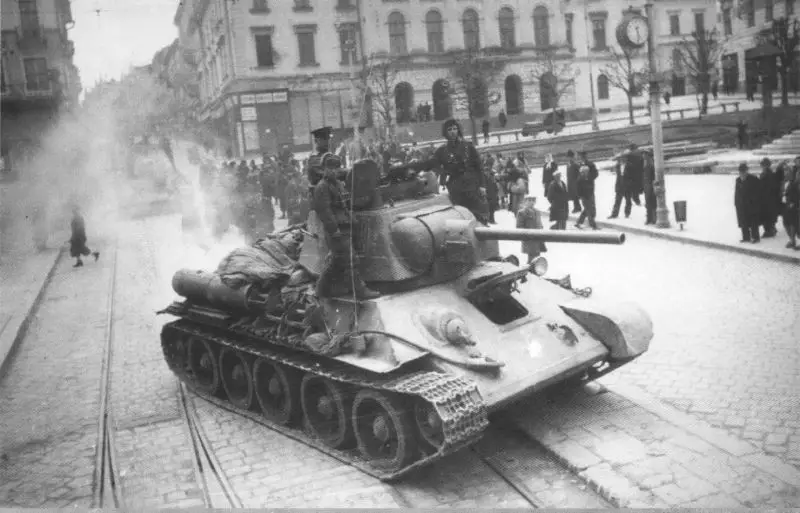
A column of Soviet T-34 tanks moves along the street of liberated Chernivtsi. 1st Ukrainian Front. March 30, 1944
As a result, the 1st German Tank Army was cut off from the 4th German Tank Army, and with the exit of the right-flank formations of the 2nd UV to the city of Khotyn, it found itself surrounded in the area north of Kamenets-Podolsky. 23 German divisions were surrounded, including 10 tank divisions. The German command faced the threat of a new Stalingrad.
Due to the mistakes of the Soviet command (Zhukov underestimated the enemy), the lack of forces, which did not allow the creation of a strong outer ring of encirclement, and the skill of the German commanders, the Germans were able to break through to their own. The commander of the 1st German Panzer Army, Hube, led the divisions to break through, although the Fuhrer ordered them to hold the line.
On April 1, 1944, the encircled group struck a weak junction between the Soviet 1st and 4th tank armies, broke through the encirclement front and began to advance towards Buchach. The success of the breakthrough was facilitated by a three-day snow blizzard, which paralyzed the work of the Soviet aviation. On April 4, a German counterattack was launched towards those breaking through and from the outer ring of encirclement (the basis of the strike force was the 2nd SS Panzer Corps transferred from France). At the cost of heavy losses, the enemy group made its way along the left bank of the Dniester to the city of Buchach, where on April 7 it united with the troops launching a counterattack from the encirclement area.
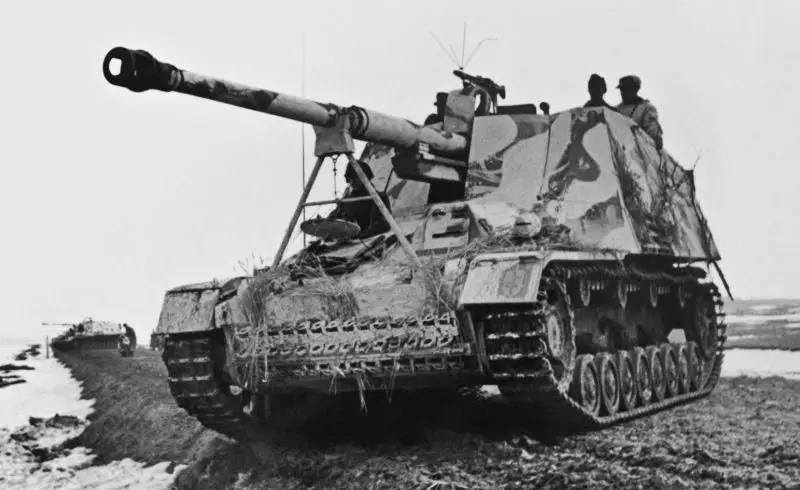
Tank destroyers "Nashorn" Sd. Kfz. 164 of the 88th battalion of heavy tank destroyers of the Wehrmacht on a country road, during the fighting in the Kamenets-Podolsk area. In the frame is the command vehicle of the battalion headquarters company. March 1944
As a result, Zhukov's troops defeated the 4th Tank Army and the 1st Tank Army of the Wehrmacht, cut the enemy front into two parts and reached the foothills of the Carpathians. However, the Germans were able to avoid encirclement and complete disaster. To close the huge gap, the German command had to transfer large forces to this direction, weakening other sectors of the front.
The advance of Soviet troops in the western and southern directions ranged from 80 to 350 kilometers, a significant part of Right Bank Ukraine was liberated: the entire Khmelnitsky region, the vast majority of the Vinnytsia, Ternopil and Chernivtsi regions, partially the Rivne and Ivano-Frankivsk regions, 57 cities, including including three regional centers of Ukraine - Vinnitsa, Ternopil and Chernivtsi.
Having reached the foothills of the Carpathians and cutting off the enemy’s main line communications, Soviet troops cut his strategic front into two parts: north and south of the Carpathians. Conditions were created for the defeat of the entire southern flank of the German troops.
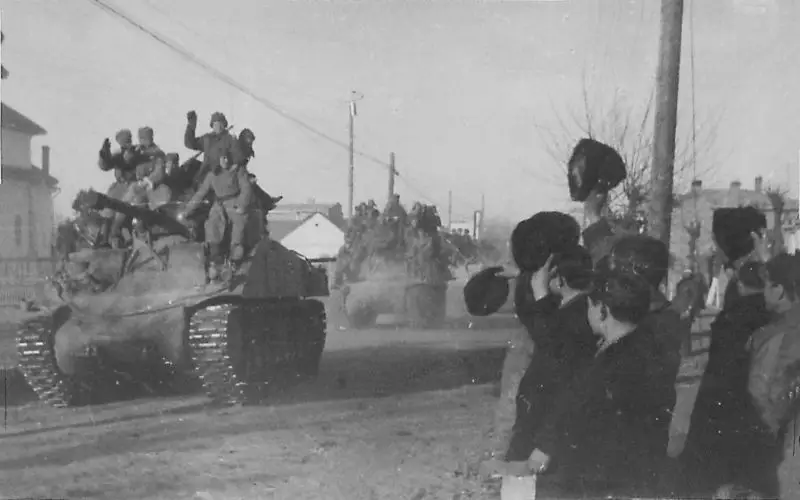
Soviet American-made M4 Sherman tanks on the street of a liberated Ukrainian city
Odessa and Crimea
Meanwhile, the troops of the 2nd UV, having crossed the Southern Bug, entered the Mogilev-Podolsky area on March 19. Front divisions crossed the Dniester and created a bridgehead on the right bank. A large gap appeared in the enemy defenses south of Tarnopol. The German headquarters transferred the 1st Hungarian Army and a number of German divisions here, but could not change the situation in its favor.
Konev’s troops, turning south and advancing along the Dniester, reached the Prut on March 26, on the border of the USSR and Romania. The German command is transferring 6 divisions of the 6th Army and the 4th Romanian Army here. But they could not stop the Red Army. Fighting was already underway for the liberation of Moldova and Romania.
Divisions of the 3rd UV crossed the Southern Bug in the lower reaches (New Odessa) and captured a number of bridgeheads. On March 28, Soviet troops liberated Nikolaev, on April 10 - Odessa (How the Red Army liberated Odessa). The German 6th and 3rd Romanian armies were defeated and quickly retreated to the west. Soviet troops completely liberated the Nikolaev and Odessa regions, as well as a significant part of Moldova. Bridgeheads were created on the right bank of the Dniester, which created the preconditions for the further advance of Soviet troops in the direction of Romania and the Balkans.
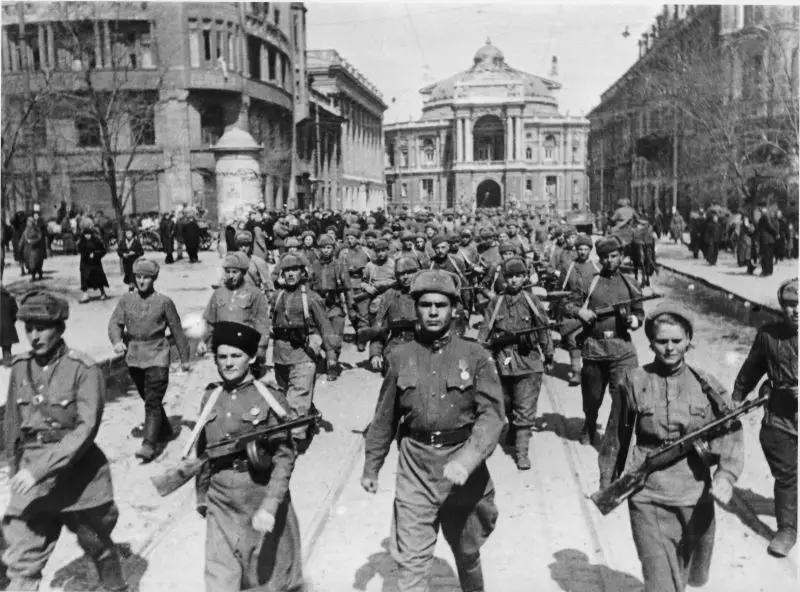
Soviet troops enter liberated Odessa. April 10, 1944
The current situation on the Right Bank was favorable for the liberation of the Crimean Peninsula. The command of the German 17th Army proposed that Hitler's headquarters evacuate troops from the peninsula. However, Hitler ordered the defense of Crimea and Sevastopol to the end.
On April 8, 1944, the 4th UV under the command of Tolbukhin began the liberation of the peninsula. The defense of the German-Romanian group was broken through in the north of the peninsula and on the Kerch Peninsula (How 80 years ago the Red Army began the liberation of Crimea; Part 2; Part 3). The Germans hastily retreat to Sevastopol. On April 11, our troops liberated Kerch, and on April 13, Simferopol, Yevpatoria and Feodosia. In mid-April, divisions of the 4th UV and the Separate Primorsky Army reached the “fortress of Sevastopol”. The Nazis stubbornly fought back. By May 9, enemy resistance was broken.
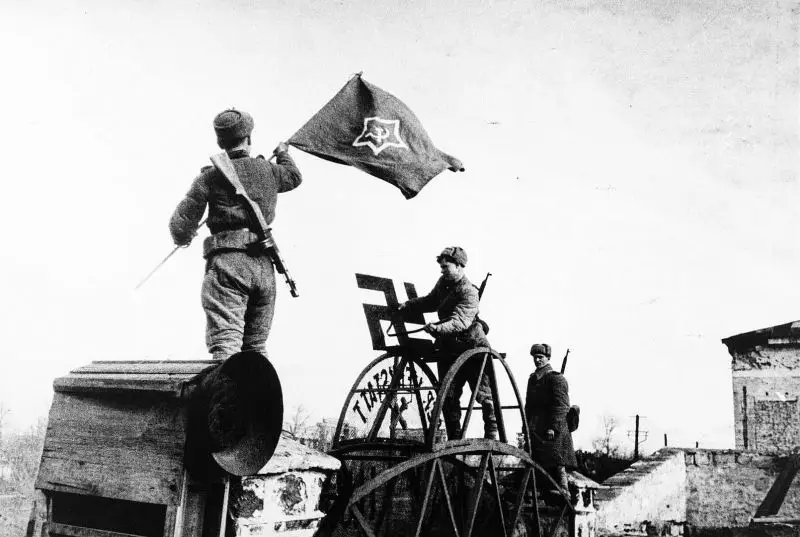
A Soviet soldier tears off a Nazi swastika from the gates of the metallurgical plant named after. Voykova in liberated Kerch. The second fighter prepares the Red Banner for installation. The city was finally liberated from the invaders on April 11, 1944
Results
The Red Army, during the strategic offensive operation on the Right Bank and in the Crimea (Second and Third Stalinist Strikes), inflicted a heavy defeat on the enemy. The front of Army Group South was torn apart, the interaction of the German army south and north of the Carpathians was disrupted. 10 German divisions were completely destroyed, others suffered heavy losses. The commanders of both German army groups, von Manstein and von Kleist, were removed from their posts and dismissed by Hitler. On March 31, von Manstein was replaced by Walter Model.
The Dnieper-Carpathian operation became one of the largest battles of the Great Patriotic War, both in its scope (troops from five Soviet fronts and two German army groups took part in it; a total of about 4 million soldiers on both sides) and in its duration (4 month). This is the only operation in which all 6 Soviet tank armies attacked.
Soviet troops on a front of 1 kilometers advanced westward from 400 to 250 kilometers, liberating the vast territory of Ukraine with a population of tens of millions of people and important economic areas. Soviet troops reached the state border of the USSR, beginning the liberation of Romania.
Conditions were created for the liberation of all of Central and South-Eastern Europe. The enemy's positions in Romania, Bulgaria and Hungary were under threat. The radical change in the strategic situation in the south influenced the policy of Turkey, which had previously been favorable to Germany.
The Black Sea Fleet regained its main base in Sevastopol and dominance in the Black Sea.
The bloody rampage of the German occupiers in most of the Right Bank of the Dnieper, in Crimea and Moldova came to an end. Pursuing a policy of mass extermination of Russian “subhumans,” the Nazis killed 4,5 million people in Ukraine. Enormous damage was caused to the national economy, social sphere and culture of the Ukrainian SSR.
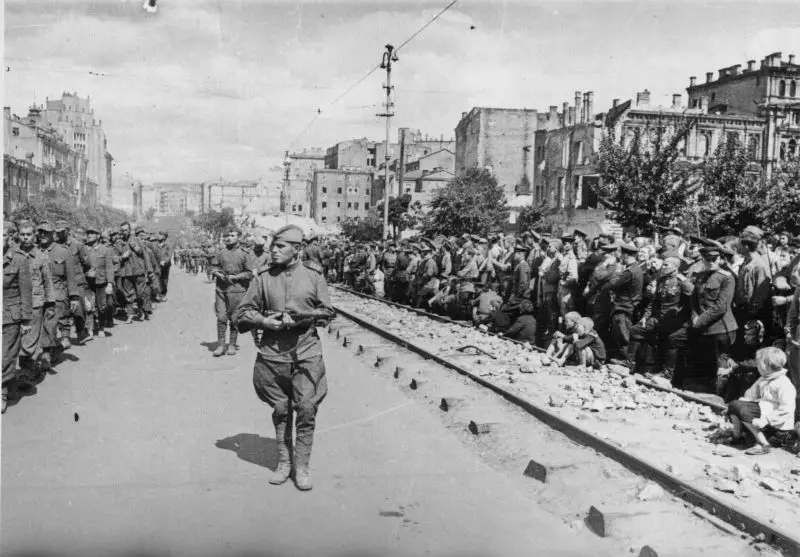
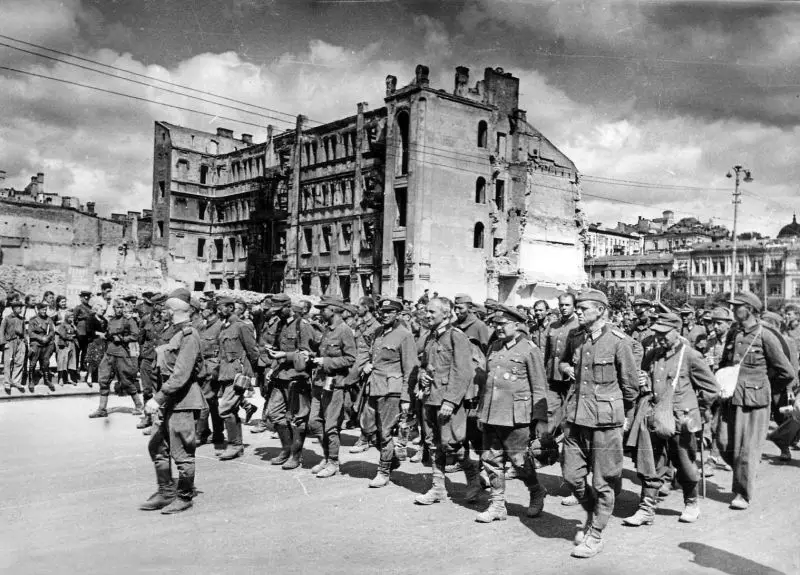
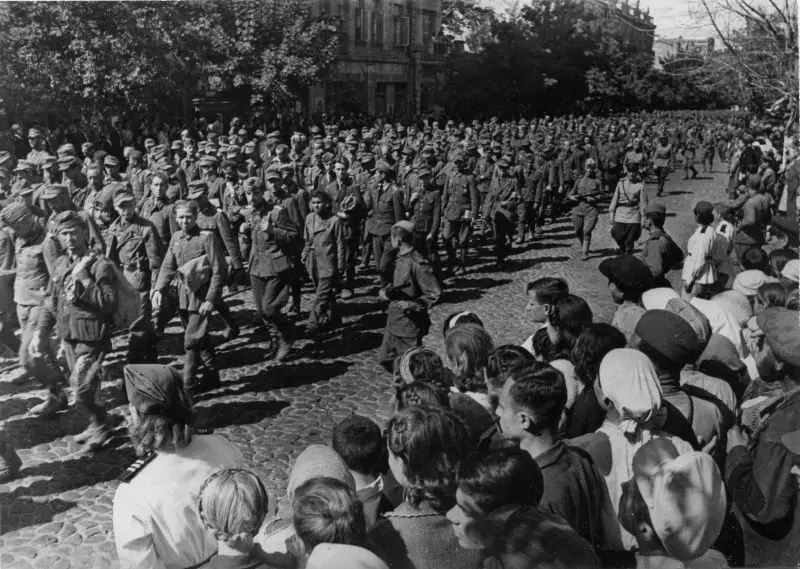
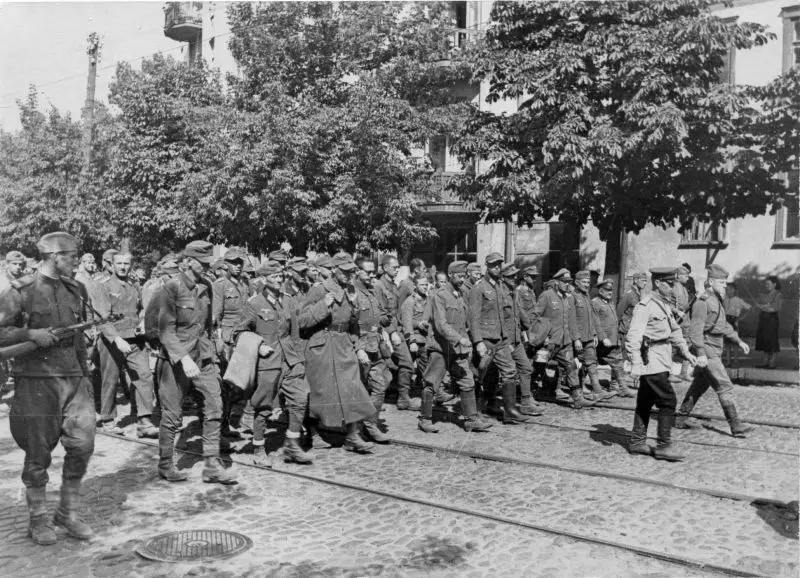
A column of German prisoners of war is led through the streets of Kyiv. Throughout the convoy's route, it is watched by city residents and off-duty military personnel. From N. Khrushchev’s report to I. Stalin: “August 16 this year. through the mountains Kyiv, a group of German prisoners of war numbering 36 people, including 918 officers, was escorted... Columns of prisoners of war passed through the streets of the mountains. Kyiv for five hours - from 549 a.m. to 10 p.m. The total length of the route through the city from the concentration point to the loading point into the trains was 15 kilometers. During the movement of prisoners of war, all the streets, windows and balconies of buildings were filled with local residents. When columns of prisoners of war appeared on the streets along the route of their movement, over 21 thousand city residents gathered... Residents of the city, who had suffered many troubles from the fascist invaders, accompanied the prisoners of war with exclamations of hatred and curses at the Germans.”
Information